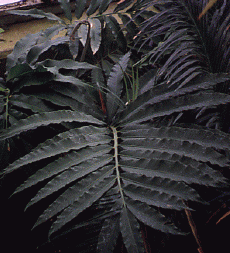The Stangeriaceae
Stangeriaceae is the smallest family of
cycads,
both in number of living and fossil species. The family contains only two
living genera, Stangeria and Bowenia,
though the latter genus has been recommended for placement in a separate
family by itself. The family is recognized by having vascularized stipules,
and by lacking cataphylls, or producing them irregularly. These
unusual characters led to the original description of Stangeria
as a fern, and it was only when seeds were later produced on the plant that
its true affinities were realized.
Though today the family occurs only in South Africa and Queensland,
Australia, fossils are known from
Jurassic
sediments in the British Isles. Recent cladistic studies suggest that the
fossil taxon Mesodescolea may also have affinities with the
Stangeriaceae. This highly lobed fossil leaf from the Lower
Cretaceous has
only been found in Argentina.
Stangeria - the Natal grass cycad
 This genus was discovered in 1839 and originally classified as a fern:
Lomaria eriopus, but plants were later found and sent to
England by Dr. William Stanger which produced cones. Realizing that a
mistake had been made, the plant was renamed Stangeria
in honor of Dr. Stanger. The genus has only one living species,
Stangeria eriopus, the Natal grass cycad.
This genus was discovered in 1839 and originally classified as a fern:
Lomaria eriopus, but plants were later found and sent to
England by Dr. William Stanger which produced cones. Realizing that a
mistake had been made, the plant was renamed Stangeria
in honor of Dr. Stanger. The genus has only one living species,
Stangeria eriopus, the Natal grass cycad.
Today, Stangeria is found only in the provinces of Eastern
Cape and Natal in South Africa; the entire range of the genus is a narrow
strip of land along the Indian coast, where it is hot and humid during the wet
summer months, and cooler with occasional frost in the drier winter.
Colonies of the cycad may be found growing in the rocky coastal grassveld
and into the shady inland forests. Plants have been known to survive annual
grass fires in the more open areas. Though somewhat frost sensitive,
Stangeria grows well under cultivation, producing luxuriant
growth if raised in a moist shady greenhouse.
Stangeria produces a large tuberous stem and root
system that is completely subterranean, with only the leaves and cones
reaching above ground. As with other low-growing cycads, the roots are
contractile, working to pull the stem further underground as the stem grows
upwards, and thus keeping the plant below ground. The stem will branch in
some individuals, producing a clonal colony.
Though they produce no cataphylls, the bases of old leaves will
often persist on the plant until growth of new leaves begins. A healthy plant
will grow up to four new leaves in the crown per year (in the wild); these
leaves vary in size depending on habitat. When growing in on open
grassland, plants produce tough leaves 25 to 30 cm long, while under forest
conditions the leaves may be as much as two meters tall, and up to a meter
broad, with softer and more flexible leaflets.
Each stem apex produces a single cone at the time of reproduction. The
cones are 10-20 cm long, with the female cones being the larger. Both male
and female cones are greenish, with a woolly covering of silvery to brownish
hairs. The specific name ("eriopus") means "woolly foot" and may refer to
this woolly covering of the cones and young leaves.
The seeds of Stangeria are light pink to brilliant scarlet and
are radiospermic. The mature seeds are dispersed by both
birds and squirrels which eat the
fleshy outer coating, but not the seed itself.

Bowenia
This genus, including the three living and two fossil species, is entirely
restricted to Australia. Bowenia eocenica is known from
deposits of a coalmine in Victoria, Australia, and B.
papillosa from deposits in New South Wales. Both fossils are of
Eocene age, and consist of leaflet fragments.
The three living species all occur in Queensland, where they grow in the
warm, wet, tropical rainforests, on protected slopes and near streams,
primarily in the lowlands.
At right is pictured Bowenia spectabilis, photographed by
Dr. Robert Ornduff at Josephine Falls in Queensland, Australia.
Bowenia is easily recognizable, since it is the only cycad
which regularly has bipinnate (doubly compound) leaves. The petiole
and central stalk of the leaf are long and slender, bearing broad arching
leaflets. These leaves are borne on separate branches from the cones,
both of which are produced from a tuberous, subterranean stem.
Cataphylls are irregularly scattered among the true leaves.
Seeds of Bowenia are cream, pinkish, or purplish, and both
seeds and leaves are toxic if ingested.

Sources:
- Cynthia Giddy. 1974. Cycads of South Africa. Purnell, Johannesburg. 122 pp.
- Douglas Goode. 1989. Cycads of Africa. Struik Winchester, Cape Town. 256 pp.
- David L. Jones. 1993. Cycads of the World. Smithsonian Institution Press 312 pp.


 This genus was discovered in 1839 and originally classified as a fern:
Lomaria eriopus, but plants were later found and sent to
England by Dr. William Stanger which produced cones. Realizing that a
mistake had been made, the plant was renamed Stangeria
in honor of Dr. Stanger. The genus has only one living species,
Stangeria eriopus, the Natal grass cycad.
This genus was discovered in 1839 and originally classified as a fern:
Lomaria eriopus, but plants were later found and sent to
England by Dr. William Stanger which produced cones. Realizing that a
mistake had been made, the plant was renamed Stangeria
in honor of Dr. Stanger. The genus has only one living species,
Stangeria eriopus, the Natal grass cycad.



